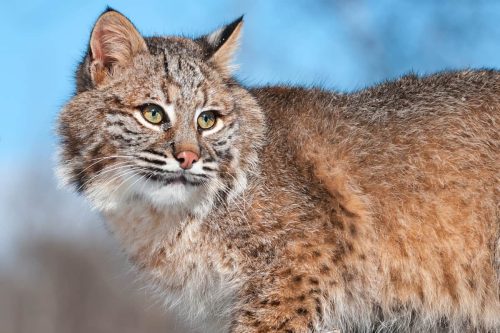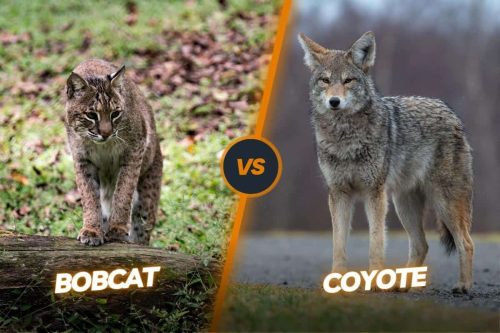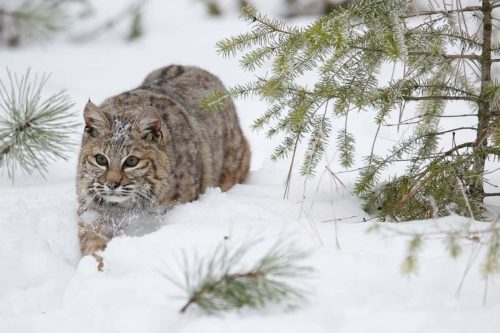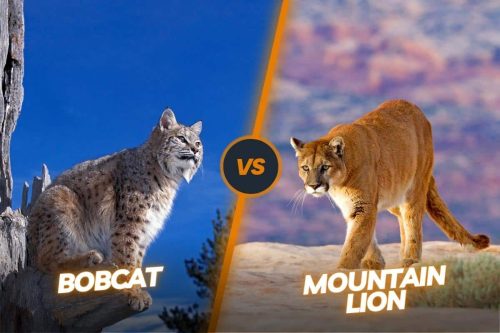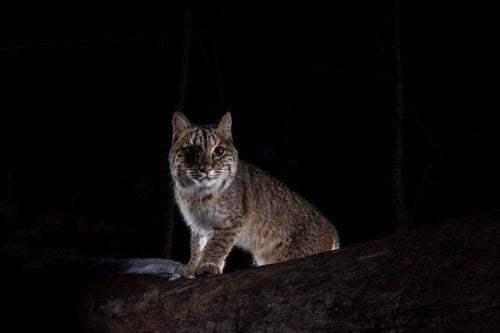Bobcat vs Rattlesnake: Nature’s Unpredictable Encounter
There is a very viral rivalry between bobcats and rattlesnakes. Both of them are notorious predators and tenacious animals. If bobcats have extraordinary strength, speed, and dense skin then rattlesnakes also come with formidable fangs and very powerful striking force.
However, both have very stealthy natures and always catch their prey surprisingly. But there is a difference between them in terms of their strength, agility, and strategy to tackle the opponent. In this article, we are going to discuss the fight between bobcat vs rattlesnake in detail and will let you know which animal can overpower the other animal in the end.
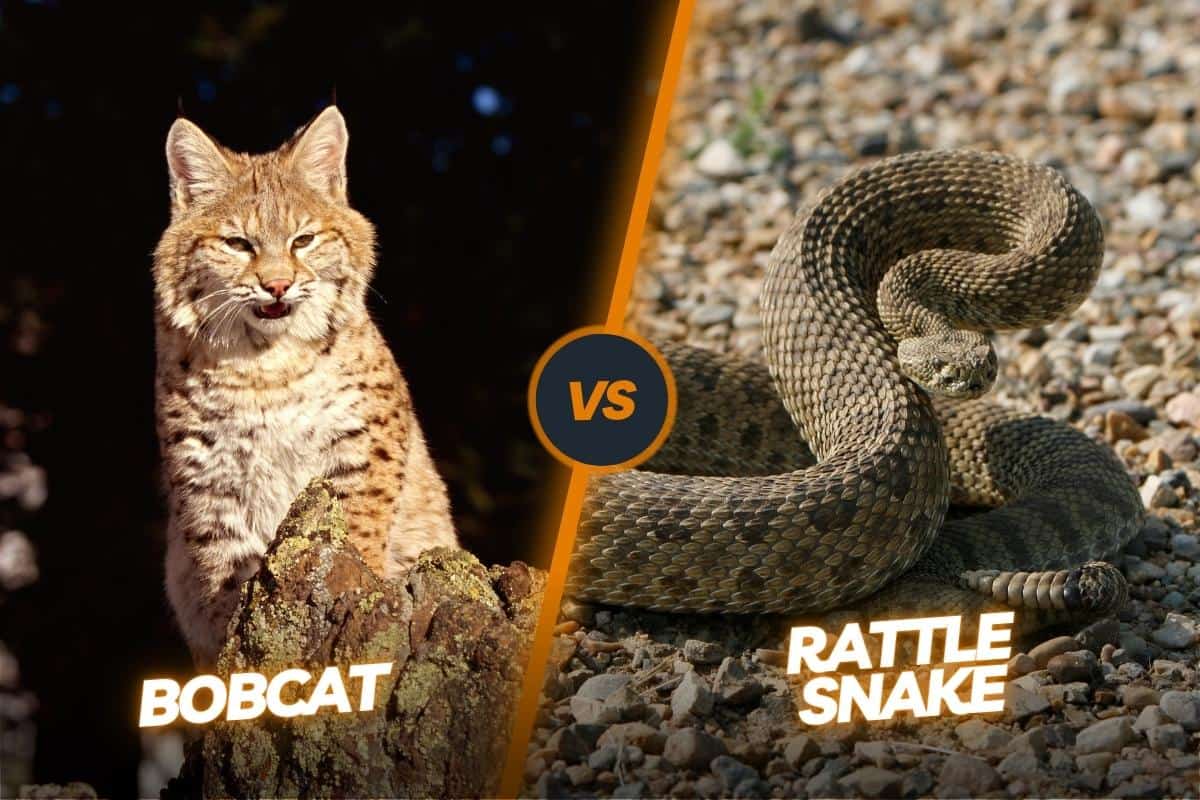
Contents
Comparing bobcat vs rattlesnake
The key differences between bobcats and rattlesnakes come in terms of their size, speed, morphology, attacking strategies, etc. We will also have a look into their predatory behavior and physical defense mechanism to find out who would be victorious in the end. It is very interesting to discuss the fight between these animals due to some serious differences between them.
| Features | Bobcat | Rattlesnake |
|---|---|---|
| Size | Height: 2 feet Weight: 40 pounds Length: 4 feet | Height: null Weight: 10 pounds Length: 8 feet |
| Speed | 30 mph | 2-3 mph |
| Attacking strategy | Biting with sharp canines and striking with claws. | Deliver venom through fangs. |
| Defense mechanism | Screaming, growling. | Open-mouthed display, rattling tail. |
| Predatory behavior | Ambushing, stalking. | Ambushing |
Size: bobcat vs rattlesnake
When it comes to size, rattlesnakes have various species and the size of these species and subspecies vary from one another. For instance, the timber rattlesnake is generally 5 feet long and could reach a maximum length of 7 feet. On the other hand, the diamondback is the largest rattlesnake species exist in the world. It can reach a maximum length of 8 feet and weigh around 10 pounds.
On the other hand, bobcats are usually 2 feet tall and 4 feet long. The average weight of the bobcat is around 40 pounds. There are also bobcats having to weigh around 50 pounds. It means rattlesnakes have an edge over bobcats when it comes to size, but the weight of bobcats is more.
Speed and Agility
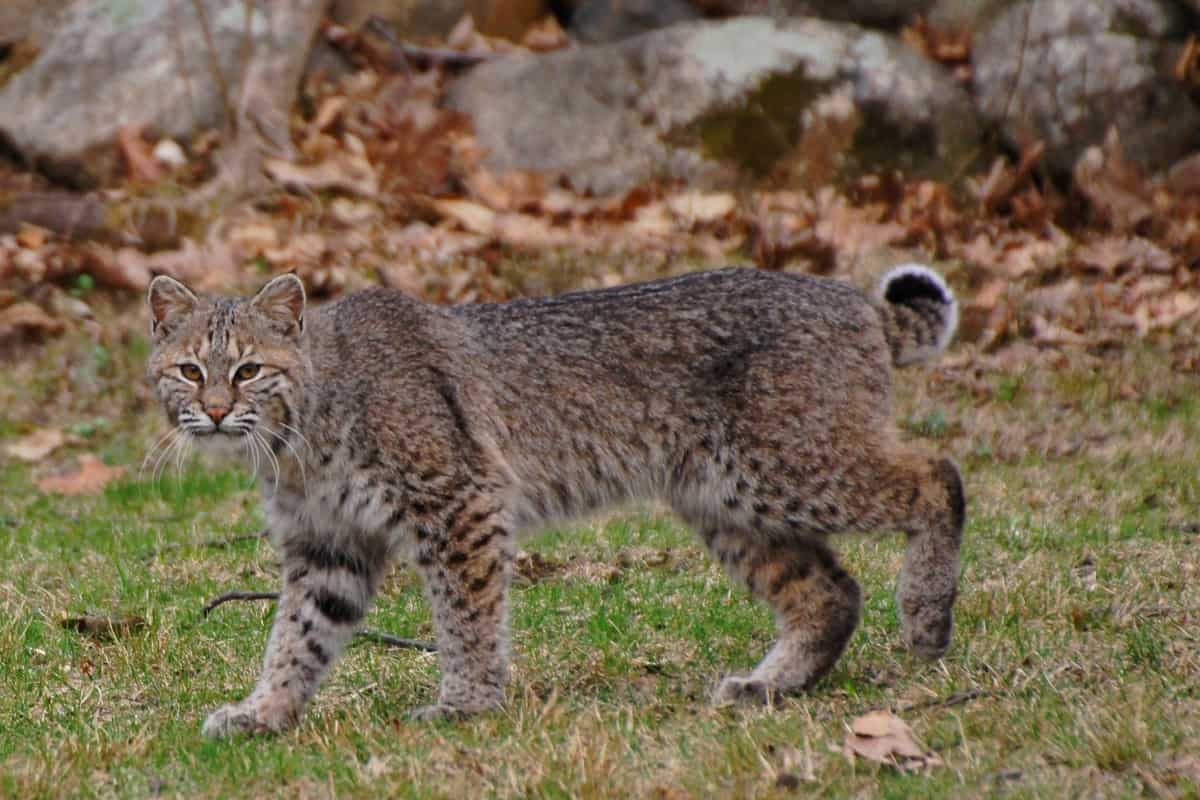
Bobcats are very fast-speed felines and could reach a maximum speed of 35 mph. Bobcats can quickly take down the prey with a single pounce even if the prey is almost 12 feet away from them. Rattlesnakes are also good in terms of their movements. They have almost 8 feet in length and can strike almost 4 feet away from their length.
Generally, rattlesnakes move very slowly with an average speed of almost 2-3 miles per hour when they are not going to strike anywhere. But these snakes can bite at a very fast speed in just the blink of an eye. However, bobcats have an edge over snakes in terms of speed and agility.
Attacking strategy: rattlesnake vs bobcat
Bobcats silently pursue their prey and then attack at the most opportune time on their prey. For this purpose, they also utilize their senses very well. Bobcats usually attack their prey with the help of their canines. They have other good teeth like incisors, molars, premolars, etc.
But they prefer to deploy only their canines for biting purposes as these teeth have the capability to make ultimate dents on their opponents. They can shear the meat into pieces with the help of these teeth. Moreover, they also come with very strong and sharp claws for tearing apart these animals.
On the other hand, rattlesnakes attack their prey by sinking their powerful fangs into their prey. They deliver their venom and it takes just a few seconds to paralyze their prey. Overall, the bobcat has an advantage over rattlesnakes in exerting a good attacking strategy.
Defense Mechanism
When rattlesnakes display an open-mouthed position and shake the rattle then it is a warning sign from the snake’s side that the opponents should not come otherwise they have to face the consequences. They may attack if the opponent starts to come near them. In the coiled position, these snakes can strike more powerfully as compared to other positions.
On the other hand, bobcats scream very wildly same like women, and give a very ferocious growl if they feel threatened or if they want to warn other animals coming near them. They could also deploy their sharp claws and teeth and agility to save themselves from other attackers. Thus, bobcats also have an edge over rattlesnakes in terms of their defense mechanism.
Predatory behavior: bobcat vs rattlesnake
The rattlesnakes have very heat-sensing organs in their eyes. They sense the presence of other animals with the help of their heat signatures. In this way, they can attack very straightforwardly even in the dark. These snakes also come with highly developed Jacobson’s organs which also help them in hunting and attacking their prey. They can wait a lot in search of an opportune time for attacking their prey.
On the other hand, bobcats can utilize their hearing as well as sighting sense to hunt down their prey. They slowly and stealthily follow their victims until they ambush their prey at the most opportune time. They catch their prey by piercing a death blow to their victims with the help of their very sharp claws.
The stalking and ambushing method of the bobcat is altogether different from the wait-and-attack strategy of rattlesnakes. These animals are almost equal in terms of their attacking behavior.
Who would be the ultimate winner in the fight between bobcats and rattlesnakes?
If the fight happens between these animals there are more chances that the bobcats would be the ultimate winner. Rattlesnakes could also give a surprise by delivering a well-timed strike and taking down the bobcat. However, bobcats have an edge in terms of their size, speed, agility, attacking strategy, and defense mechanism.
Bobcats also have the capability to dodge the rattlesnake attack with an agile dance of their bobs and weaves. Rattlesnakes also have very limited striking potential as they need a lot of time for attacking a second time after making the first attempt.
Bobcat first blocks the rattlesnake attack with the help of its claws and gives the final blow when it finds the rattlesnake has worn down. The bobcats usually tear apart the flesh of the snakes and utilize it as a source of food after winning the fight.
Can a rattlesnake kill a bobcat?
Yes, the rattlesnake can kill a bobcat only if they are successful in biting the bobcat several times. Bobcats get killed as they are not immune to snakes’ venom. However, most of the time bobcats take down rattlesnakes and eat them afterward.
Has a rattlesnake ever killed a bobcat?
There is actually no proof or recorded incident about the killing of the bobcats by the rattlesnakes. However, it does not mean that it would never have happened. It might have happened without our notice. Bobcats come across rattlesnakes a lot of time and usually snakes act as a snack for bobcats.
Sometimes the bobcats also just knock away the head of rattlesnakes without killing them. Most of the time bobcats walk away without any injury and have a rattlesnake in their mouth.
Why do bobcats attack rattlesnakes?
Rattlesnakes could be a potential source of food for the bobcats. These cats also know that they can move unscathed after killing the snakes. There are chances of bobcats winning as they are more powerful, agile, and vicious. Bobcats also know if they don’t attack and kill snakes then these snakes might attack them and kill them. Thus, they mostly act out of fear to save their own life from the snakes.
Frequently asked questions
Conclusion
The fight between bobcat and rattlesnake is very interesting to discuss as both animals are very fierce as well as vicious creatures. We have discussed this fight in detail by comparing in detail all the prominent features of these animals. By comparing these animals, we have come to the conclusion that if a fight happens between these animals then the bobcat would be the ultimate winner as these cats are much better in terms of their size, speed, movement, agility, predatory behavior, defense mechanism, offensive capabilities, etc.

Izzy is an experienced ranch worker who has a passion for exploring nature and getting up close to wildlife. With her connections to various animal organizations, Izzy is well-versed in animal care and rehabilitation.




